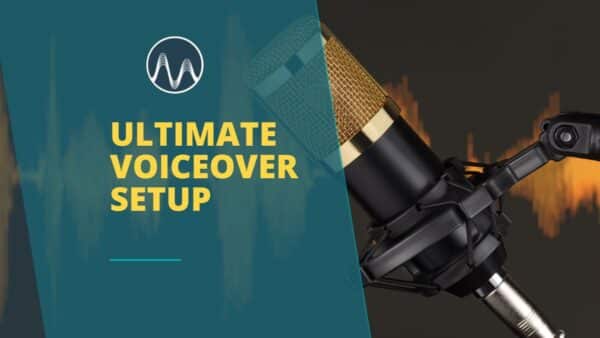If you’re a voiceover artist or podcaster looking to take your recordings to the next level, setting up a solid voiceover studio is essential. In this guide, we’ll walk you through a professional plugin chain designed to give your voiceovers a polished, studio-quality sound—using the Universal Audio Apollo Twin X audio interface and three iconic plugins: the SSL 4000 E Channel Strip, the Neve 1073 Preamp & EQ, and the Teletronix LA-2A Leveling Amplifier.
These tools are digital emulations of legendary analog gear, trusted by top engineers. We’ll walk you through the exact settings used in a real-world voiceover studio to help you get crisp, clean results—without the complicated jargon.
Voiceover Studio Essentials: The Gear You’ll Need
To create a pro-quality voiceover studio setup, you’ll need a few key components:
- Universal Audio Apollo Twin X: A high-quality audio interface with onboard DSP (digital signal processing) to power advanced plugins.
- SSL 4000 E Channel Strip: A flexible plugin that handles compression, gating, and EQ—ideal for shaping your voice from the very beginning.
- Neve 1073 Preamp & EQ: Known for its rich analog tone, it adds warmth and clarity.
- Teletronix LA-2A Leveling Amplifier: A legendary compressor/limiter that smooths out your sound for that final broadcast polish.
These plugins run on Universal Audio’s UAD-2 platform and work seamlessly in DAWs like Adobe Audition, making them perfect for your voiceover studio workflow.
Step 1: Set Up the SSL 4000 E Channel Strip in Your Voiceover Studio
What It Does
The SSL 4000 E Channel Strip is your all-in-one plugin to start shaping your voice. Based on the legendary SSL 4000 console, it provides:
- Compression: Keeps your voice consistent in volume.
- Gating: Reduces background noise in your recording space.
- EQ: Helps you shape the tonal character of your voice.
Recommended Settings for Voiceover Work
Input Section
- Line/Mic Gain: Set to 0 dB (adjust as needed)
- Phantom Power: On (48V) for condenser mics like the Neumann U87
- XFMR Button: On (adds analog warmth)
Dynamics Section
- Compressor Ratio: 2:1
- Threshold: –15 dB
- Attack: Fast (~10 ms)
- Release: ~0.2 seconds
- Gate Threshold: –12 to –20 dB
- Gate Range: 25 dB
EQ Section
- HF: Slight boost at 7.5 kHz
- HMF: Slight cut below 6 kHz
- LMF: Cut around 200 Hz
- LF: Boost at 100 Hz
- Filters: High-pass at 70 Hz, Low-pass at 12 kHz
Why It Works
This plugin is crucial to achieving a clear, professional voiceover studio sound. It reduces unwanted noise, controls dynamics, and enhances vocal clarity—laying the foundation for everything that follows.
Step 2: Add Character with the Neve 1073 Preamp & EQ
Why It’s a Studio Favorite
The Neve 1073 is known for adding warmth and depth—ideal for making voiceovers sound full and engaging. In a voiceover studio, it helps shape the personality of your voice.
Settings for Best Results
EQ Section
- High Frequencies: Slight cut at 7.2 kHz
- Mid Frequencies: Slight boost at 0.7 kHz
- Low Frequencies: Gentle cut below 60 Hz
- Low-Frequency Selector: 160 Hz (acts as high-pass)
Output
- Output Slider/Knob: 0 dB
- Pad: Set to HI
Why It’s Essential
In any voiceover studio environment, the Neve 1073 helps refine vocal tone—removing low-end muddiness and bringing out midrange clarity. The result is a voice that cuts through cleanly and warmly.
Step 3: Final Polish with the Teletronix LA-2A
What It Does
The Teletronix LA-2A is a smooth, vintage-style compressor that adds that final layer of polish to your voice. In a professional voiceover studio, this plugin helps maintain even dynamics and give your voice that “radio-ready” finish.
Suggested Settings
- Mode: Limit
- Gain: Slight boost (~30)
- Peak Reduction: 25
- Meter: Gain Reduction
Why You Need It
This step smooths out remaining volume spikes and adds a subtle, analog finish—perfect for a voiceover studio where consistency is key.
Vocal Chain Summary: Your Voiceover Studio Plugin Flow
Here’s how everything flows in your voiceover studio chain:
- SSL 4000 E Channel Strip – Clean and shape your voice
- Neve 1073 Preamp & EQ – Add warmth and tone
- Teletronix LA-2A – Final dynamic polish
Voiceover Studio Tips for Customization
- Match Your Mic: Settings here were optimized for a Neumann U87, but they’ll work with most studio mics like the Shure SM7B.
- Tweak to Fit Your Space: If your voiceover studio has some background noise, adjust the gate settings on the SSL.
- Use Your Ears: These settings are a great starting point, but fine-tune them to suit your unique voice and recording environment.
Final Thoughts
With the Apollo Twin X and this carefully designed plugin chain, you have everything you need to create a high-quality voiceover studio setup. Whether you’re recording audiobooks, narration, or podcasts, this workflow will help you deliver consistent, professional-grade results. You can spice up your sound with carefully prepared presets. Our team helps voice over artists achieve the best sound.
